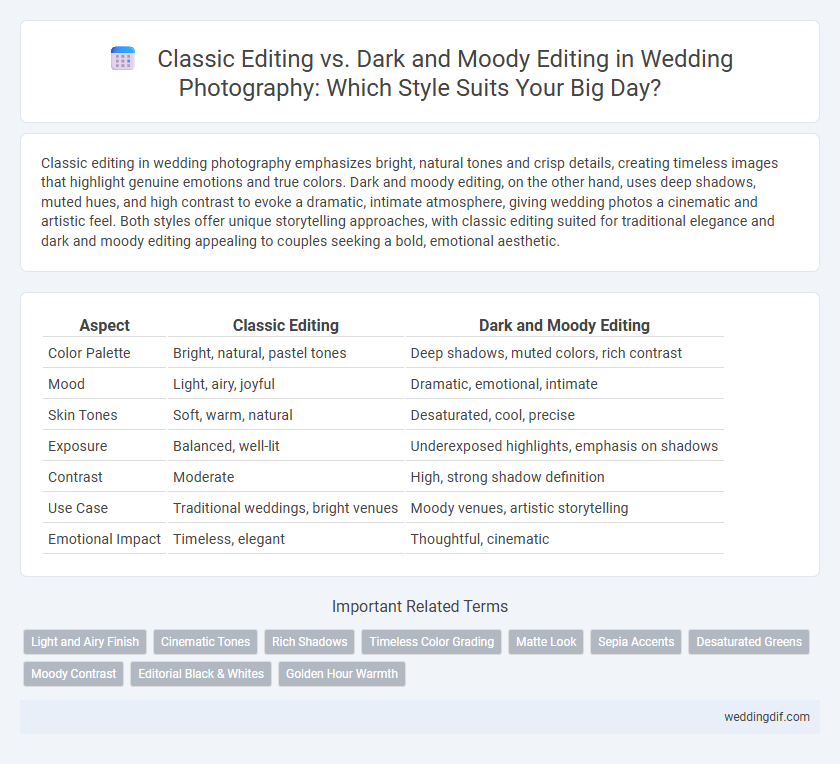Classic editing in wedding photography emphasizes bright, natural tones and crisp details, creating timeless images that highlight genuine emotions and true colors. Dark and moody editing, on the other hand, uses deep shadows, muted hues, and high contrast to evoke a dramatic, intimate atmosphere, giving wedding photos a cinematic and artistic feel. Both styles offer unique storytelling approaches, with classic editing suited for traditional elegance and dark and moody editing appealing to couples seeking a bold, emotional aesthetic.
Table of Comparison
| Aspect | Classic Editing | Dark and Moody Editing |
|---|---|---|
| Color Palette | Bright, natural, pastel tones | Deep shadows, muted colors, rich contrast |
| Mood | Light, airy, joyful | Dramatic, emotional, intimate |
| Skin Tones | Soft, warm, natural | Desaturated, cool, precise |
| Exposure | Balanced, well-lit | Underexposed highlights, emphasis on shadows |
| Contrast | Moderate | High, strong shadow definition |
| Use Case | Traditional weddings, bright venues | Moody venues, artistic storytelling |
| Emotional Impact | Timeless, elegant | Thoughtful, cinematic |
Understanding Classic vs Dark and Moody Wedding Editing
Classic wedding editing emphasizes bright, natural colors and soft lighting to preserve the authentic joyful atmosphere, while dark and moody editing uses deep shadows, high contrast, and muted tones to create a dramatic, emotional effect. Photographers often choose classic editing to highlight timeless elegance and true-to-life moments, whereas dark and moody styles evoke a cinematic, intimate ambiance. Understanding the differences helps couples select an editing style that aligns with the wedding's theme and their personal aesthetic.
Key Characteristics of Classic Wedding Editing
Classic wedding editing emphasizes natural skin tones, bright and airy compositions, and timeless color balance to create images that look elegant and authentic. It typically involves soft contrast and subtle enhancements that maintain the original atmosphere of the wedding day without heavy manipulation. This style appeals to couples seeking a traditional and timeless aesthetic that will remain appealing and relevant over the years.
Defining Features of Dark and Moody Editing Styles
Dark and moody wedding editing features deep shadows, rich contrast, and desaturated tones that create an intimate and dramatic atmosphere. This style emphasizes texture and emotional depth by using low-key lighting and muted color palettes, often enhancing skin tones with cooler or earthy hues. Classic editing, in contrast, maintains bright, natural colors and soft highlights for timeless and airy images.
Pros and Cons of Classic Editing for Weddings
Classic editing for weddings emphasizes natural colors and balanced exposure, preserving the timeless and authentic feel of the ceremony. It enhances skin tones and brightens details, ensuring the final images are universally appealing and suitable for traditional print albums. However, this style may lack dramatic contrast and emotional depth compared to dark and moody editing, potentially resulting in less artistic impact.
Advantages and Drawbacks of Dark and Moody Wedding Edits
Dark and moody wedding edits emphasize deep contrasts and rich shadows, creating a dramatic, timeless atmosphere that enhances emotional depth and artistic expression. These edits can highlight intricate details and evoke a cinematic feel but may obscure certain elements or reduce overall brightness, potentially compromising clarity and natural color representation. Photographers must balance the intensity of the dark tones to avoid overshadowing key moments while appealing to couples seeking a unique, evocative aesthetic.
How Lighting Influences Each Editing Style
Classic editing in wedding photography emphasizes bright, natural lighting that highlights soft, warm tones and crisp details, creating timeless and elegant images. Dark and moody editing relies on low-key, dramatic lighting to produce rich shadows and deep contrasts, evoking an intimate and emotional atmosphere. Lighting plays a crucial role in defining the mood and storytelling in each style, shaping the overall aesthetic and emotional impact of the wedding photographs.
Emotional Impact: Classic Versus Dark and Moody Edits
Classic wedding photography editing emphasizes bright, natural tones that highlight joyful and romantic emotions, creating a timeless and elegant atmosphere. Dark and moody edits use deep shadows and muted colors to evoke a sense of intimacy, drama, and nostalgia, adding a cinematic and emotional depth to the images. Each style influences viewer perception, with classic edits fostering warmth and celebration, while dark and moody edits emphasize emotional complexity and storytelling.
Choosing the Right Style for Your Wedding Theme
Classic editing enhances wedding photos with bright, natural tones and crisp details, perfectly complementing traditional and romantic themes. Dark and moody editing creates dramatic contrast and muted colors, ideal for couples seeking a cinematic and intimate atmosphere. Choose the style that aligns with your wedding's mood and venue to ensure your photos authentically represent the day's emotional tone.
Tips for Photographers: When to Use Each Editing Style
Classic editing enhances weddings with bright, natural tones that emphasize clarity and timeless elegance, making it ideal for daytime ceremonies and outdoor venues. Dark and moody editing uses deep shadows and desaturated colors, perfect for intimate settings or creative storytelling with emotional depth. Photographers should choose classic for vibrant, joyful atmospheres and dark moody for dramatic, artistic portraits that highlight contrast and texture.
Final Thoughts: Classic or Dark and Moody – Which Suits You?
Choosing between classic editing and dark and moody styles for wedding photography depends on the couple's personal aesthetic and the desired atmosphere of their memories. Classic editing emphasizes natural colors and bright, clean images that highlight timeless elegance, while dark and moody editing uses deep shadows and rich tones to create dramatic, emotional storytelling. Understanding these stylistic differences helps photographers deliver a final product that resonates authentically with their clients' vision.
Classic Editing vs Dark and Moody Editing for weddings. Infographic

 weddingdif.com
weddingdif.com